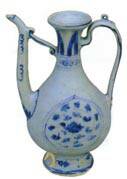Porcelain is the best known type of all pottery. Porcelain is sometimes referred to as 'Blue and white' from its contrasting color or 'Underglaze blue' from its blue cobalt oxide below the glaze.The reason Chinese porcelain becomes so famous could probably be found in the Europeans and American's East India ships, trading with China from the 17th century. At that time, China had already exported blue and white porcelain to the Middle East and Southeast Asia for three centuries. Despite this great success in ceramic history, porcelain was not the reason the early European's were drawn to Asia. It was spices!
The first Portuguese merchants to visit China eventually realized the value of the "white gold" and started importing limited quantities for the nobles of Europe. It was however first in 1603 that the Dutch East India Company (VOC) sent a load of porcelain to Amsterdam where it was sold for enormous profit
Following that date Chinese blue and white porcelain become a much desired product in Europe and the United States which eventually interested antique collectors. China's earlier and traditional ceramics like the underglaze black decorated wares and celadon, is still today not that well-known
During the early part of the Yuan dynasty (1280-1368), potters at Jingdezhen, China, succeeded in decorating whitish local clay with blue cobalt oxide under a clear glaze, overcoming earlier technical difficulties relating to both the colors and the glaze. The date of this major event in ceramic history is much debated, but it is believed that it could have been as early as AD 1300.
Production of blue-and-white ceramics developed rapidly during the Ming dynasty (1368-1644), greatly influenced by the imperial court and its stringent requirements. Although 'imperial' kilns in the Jingdezhen area also made trade ware, those at Shantou (Swatow), Dehua and other parts of Fujian produced most of the exports for Southeast Asian markets
Following the death of emperor Wanli (1573-1619), unsettled dynastic politics eventually allowed Manchurians to conquer the country (the Qing dynasty, 1644-1912). The imperial kilns at Jingdezhen closed, and were first reopened by emperor Kangxi only in 1663.
The period between 1619 and 1663 when most, but not all, the imperial kilns were closed, is referred to as the 'transitional period'. It is believed that the imperial potters, temporarily without work, assisted the private kilns with the manufacture of blue-and-white ceramics. The sudden release from the strict guidelines of the court gave craftsmen the opportunity to express individual talents. A new spontaneity can be seen in the artistic freedom of the painting, the choice of motifs, and the quality of brilliant blue cobalt under a clear and smooth glaze.



Traditional cobalt blue motifs from the
'Transitional' period
Antique Chinese Porcelain
Blue and white or Underglaze blue porcelain
With the entry of European traders in China, the Chinese potters painted just about anything the "strange white people" wanted. Without any appreciation for Chinese tradition, the foreigners specified their own motifs and the European export porcelain appeared accordingly. With greater success in Europe and later in the USA, it accelerated the devolution of Chinese potting tradition. The exported porcelain was Chinese alright but only made by Chinese people and local clay. No tradition, no individualism and and long gone was the mythological motifs and the traditional floral designs the Chinese themselves had appreciated for centuries before. To view some of the symbols used in the Wanli (AD.c. 1625) shipwreck, click here.

Chinese porcelain Ewer
from the early 16th century.
Although its reign mark indicate that it was made during the reign of emperor Xuande (1425-1436) the ewer was made one century later


Transitional period
porcelain bowls

 | ||||
An interesting reflection on the age of China's and Southeast Asian traditional pottery:
The Turiang ship (1370) that was loaded with Chinese celadon and Thai underglaze black wares, sank more than a century before Christopher Columbus found the 'New World'.
When the Swedish East India Man "Gotheborg" sailed to China in 1745 to buy what is antiques today, she sailed right over the Royal Nanhai (1460) shipwreck that, already then had three century old celadons onboard!
Click here to add text.
For a more detailed description of the production, transport and historical development at Jingdezhen; the worlds porcelain center, click here.
THE ONLY PLACE WHERE YOU CAN BE SURE TO BUY GENUINE ANTIQUES
Nanhai Marine Archaeology Sdn. Bhd. was incorporated on the recommendation of the Malaysian authorities. This was done in order to formalize and to expand on the company’s researcher’s extensive knowledge of Asia’s ceramic developments and maritime trade.
The company’s researchers have been engaged in the search for historical shipwrecks for more than two decades and another decade researching maritime trade. Most of this work is concentrated to the South China Sea, a virtual highway for ancient shipping linking China to India, the Middle East and Southeast Asia in an extensive maritime trade system. This ancient trade started sometime around the 4th century and lasted well into the 19th century.
Following a successful shipwreck discovery, the company obtain a government permit to excavate the wreckage, and then carry out detailed marine archaeological procedures in recovering the artifacts, mapping the ship's remains and securing other data for future research. After each concluded project and following conservation of recovered artifacts, we search for and pinpoint ruined kiln sites and compare its wasters with the recovered ceramics until we are satisfied we located the place in which the shipwreck pottery was made centuries earlier.
As such we have precisely located a kiln sites in Sisatchanalai, northern Thailand in which our Royal Nanhai and the Nanyang shipwreck celadon ware was made around AD. 1380-1460. (See videos on: http://www.ming-wrecks.com/photopage.html ) Other kilns was located in Sukhothai where production wasters matched the fish and flower plates found on the Turiang and the Longquan shipwreck. These unique underglaze decorated wares was made at those exact kilns 600 years earlier! Our latest shipwreck cargo; The Wanli Shipwreck, of Chinese blue and white porcelain, was likewise pinpointed to the Guangyinge kiln site in Jingdezhen, China. (See video on: http://www.ming-wrecks.com/photopage.html )
Our arrangement with the Malaysian authorities is such that we finance all operations and train young Malaysian nationals (on our initiative) in maritime archaeology and related research. After giving all unique and single artifacts and thirty percent of all recovered items to the National Museum (and assisting with exhibitions of artifacts from each project) we are allowed to sell our portion of the recovery to finance future projects. The findings from ongoing research and the compilation of reports, books and catalogues are available on these pages as well as on a separate Internet site: http://www.maritimeasia.ws
Due to the unquestionable authenticity and precisely dated shipwreck pottery, many International Museums now display our shipwreck pieces as reference material.
The artifacts sold on this website are therefore legally and properly excavated and can be supplied with an export permit from the Department of Museum in Malaysia should this be required. This unique working arrangement makes us one of the few Internet sellers that sell from own excavation and issues a meaningful Certificate of Authenticity with all artifacts with a serial number.
So, if you are interested to purchase some of our Antique porcelain, old time pottery or other shipwreck artifacts from the Song dynasty, Ming porcelain or Chinese blue and white porcelain or the famous Yixing teapots, you can rest assured that every piece is excavated through proper archaeology by our own staff. We do not sell anything that is not excavated by ourselves or properly recorded and researched before offered for sale so every piece comes with the “Best possible provenance”
WE ENCOURAGE YOU TO EMAIL OUR PRINCIPAL RESEARCHER; Sten Sjostrand SHOULD YOU HAVE ANY QUESTIONS ABOUT YOUR POSSIBLE PURCHASE
CLICK ON BELOW IMAGES TO VIEW OUR SALES PAGES
 | ||||
Nanhai Marine Archeology Sdn. Bhd.
CLICK ON ABOVE IMAGES TO VIEW OUR SALES PAGES.
OTHER WEB PAGES RELATED TO ANTIQUE CELADON, CHINESE PORCELAIN,
SHIPWRECK POTTERY AND ANTIQUES FOR SALE








